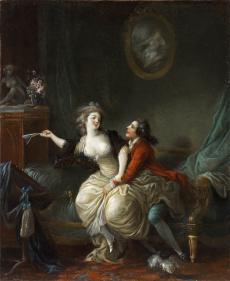


The one aspect of 18th-century French painting that has barely ever been the object of serious study is that of the galant subjects of the last third of the century, ranging in character from the suggestive or mildly erotic to the gently pornographic. It is better known and studied in the form of drawings and prints than in that of oil paintings. Its best-known practitioners were, indeed, primarily either draughtsmen – such as the two illustrators of the Monument du costume physique et moral de la fin du XVIIIe siècle (1774 - c. 1781), Sigmund Freudeberg (Freudenberger; 1745-1801) and Jean-Michel Moreau (Moreau le Jeune; 1741-1814) – or practitioners of gouache, such as Pierre-Antoine Baudouin (who actually lived a little earlier, 1723-1769, but whose works were often engraved later) and Jean-Baptiste Mallet (1759-1835). Less known for his paintings of this kind, much better known for his little pictures of single, elaborately costumed (and often dancing) women (see AGLG 370), is Jean-Frédéric Schall. Ignored by both the Goncourts and Emilia, Lady Dilke, he did not feature even in the most comprehensive survey of 18th-century French art of the last 50 years, France in the Eighteenth Century.
The present painting contains a double enigma as to its authorship. The composition was published around 1785 by Louis-Marin Bonnet (1736-1793) as a stipple colour print, the same way round, with the title given here, but without any name of either artist or engraver (see AGLG 448). It was not uncommon for prints of slightly equivocal subjects to omit the originating artist’s name or to substitute a bogus one. Lot 6 in Bonnet’s posthumous sale (7 November 1793), however, consisted of a pair of paintings on copper, of the same size as the present one (10 pouces x 8 pouces), one with the title given here, and the other with that of its engraved pendant, L’Amant Écouté (see AGLG 449). These subsequently reappeared in the auction of G. Mühlbacher’s collection, measured slightly differently (probably by sight-size), but – curiously – as by Jean-Baptiste Huet (1745-1811). This was almost certainly because, their true authorship having been forgotten, Huet’s name had become irrevocably associated with the anonymous prints after them. Huet, rather than Schall, may have been assumed to be the author of the compositions because of another pair of such subjects engraved by Augustin Legrand (1765-1815) and published with both his and Huet’s names by Bonnet, as La Déclaration and L’Amant Pressant.
Schall’s authorship of L’Eventail Cassé is, however, further secured by a signed and dated variant of the panel, of 1785, of the same figures, but in an outdoor setting. This was published by André Girodie in the sole serious study of the artist, when it was in the collection of Alfred Lindon, who had acquired it in the sale of E. Vincent in 1872; and it was included in the exhibition devoted to Schall at the Hôtel Charpentier, Paris, in 1929 (no. 21). More recently, a larger version of this on panel, measuring 42 x 34 cm, signed and dated 1795, was in the 2002 catalogue of the Galerie Maurice Segoura, Paris (pp. 164-165). Despite all this, however, a version of L’Amant Écouté on panel was auctioned at Sotheby’s, Monaco, in 1986 as by J.-B. Huet.
The identity of the author of the composition of L’Eventail Cassé is thus one enigma, albeit one in which all indications point to his being Jean-Frédéric Schall. The answer to the other enigma – was Schall himself the executant of the present copper? – is a little less clear-cut. Its dimensions are the same as those of the copper in Bonnat’s posthumous sale, in which it and its pendant were ascribed to him, but there appears to be a palpable difference in the refinement of the execution, not only of it, but of the later outdoor version of 1795, when compared with, for instance, the pair of paintings of a young woman dressing and undressing, Le Lever and Le Coucher, which were together until Mme André Saint’s sale in 1935, when the latter was acquired by Sir Henry Deterding and given by him to the Rijksmuseum in Amsterdam the following year. Could it be that the small paintings of L’Eventail Cassé and L’Amant Écouté on panel (only the latter being at present known from its auction at Sotheby’s, Monaco, in 1986) were Schall’s original versions, and the coppers (only the present one, of L’Eventail Cassé, being known today) autograph replicas, made for Bonnet’s engraver to work from – hence their having remained in Bonnet’s possession until his death?
He studied at the Académie Royal de Peinture et de Sculpture in Paris under Nicolas-Bernard Lépicié. He worked in the Rococo idiom of François Boucher and Jean-Honoré Fragonard; he is known chiefly for his galant paintings of elaborately dressed women, usually dancing, in landscape settings and for his mildly erotic scenes.